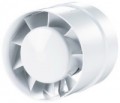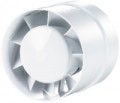Type of bearing
The type of bearing installed in the fan.
The bearing is a part that secures the rotating part of the fan to the stationary part and reduces friction between these parts. By type, it can be as follows:
— Plain bearing. The action of such bearings is based on the friction between two conjugated, that is, directly pressed one to the other over the entire area, surfaces. However, these surfaces are in contact with each other relatively weakly — between them is a layer of lubricant that reduces friction. In addition, to reduce resistance, rubbing parts are usually carefully polished and made of anti-friction materials. The main advantage of plain bearings is the simplicity of design and the resulting low cost. However, such parts are less durable than ball bearings, and they create more noise.
— Ball bearing. The principle of operation of a ball bearing is that a set of balls is placed between its movable and stationary parts, which roll inside during movement. Compared to plain bearings, such bearings last much longer, and they create less noise during operation. On the other hand, fans with similar equipment are noticeably more expensive.
Air flow (extraction)
This parameter describes the amount of air that the fan can pass through itself per hour when operating in extraction mode (see "Type"). It is one of the key characteristics of any extractor fan — it characterizes the overall performance and suitability of the unit for a particular room.
When choosing a fan for
maximum performance, two main indicators must be taken into account — the volume of the room and the air flow rate. The volume can be found by multiplying the area of the room by the height of the ceilings: for example, for a room of 12 m² in a residential apartment with standard ceilings of 2.5 m, this figure will be 12x2.5=30 m³. The air flow rate describes how many times per hour the air in an enclosed space must be completely replaced for ventilation to be sufficiently effective. This multiplicity is different for different types of premises: in particular, for the kitchen, it is 6-8, for the bathroom — 8-10, etc. More detailed values be found in specialized sources, in particular, sanitary standards. And the minimum required fan performance is calculated by multiplying the air volume by the air exchange rate. For example, if we have a bathroom with an area of 4 m² with the same ceiling of 2.5 m, then the volume of air in it will be 4x2=10 m³; Considering that the minimum air exchange rate for bathrooms is 7, for this room we need a fan with a capacity of at least 70 m³/h.
Protection level
The level of protection of the fan housing (more precisely, sensitive parts located in the housing) from dust and moisture, measured by the IP standard. This standard assumes marking in the form of two numbers after the letters IP — for example, IP54. In this case, the first digit describes the level of protection against dust and other objects, and the second — from moisture.
In terms of resistance to the penetration of foreign objects in fans, the following values \u200b\u200bcan be found:
2 — protection against objects larger than 12.5 mm (enough to protect against adult fingers);
3 — from objects larger than 2.5 mm;
4 — from objects more than 1 mm (not every wire can get inside);
5 — full protection against objects; a small amount of dust may have entered the unit without any noticeable effect on performance.
In terms of water protection, options can be as follows:
4 — resistance to water splashes from any direction;
5 — resistance to water jets from any direction;
7 — the ability to endure short-term immersion in water to a depth of 1 m without consequences.
There are also higher rates of water protection. However, it does not make sense to provide them to fans. The mentioned "4" and "5" are quite sufficient for installation in bathrooms, showers and most other places where there is
...a possibility of moisture getting on the units, higher levels of protection complicate and increase the cost of the design, and there is very little practical need for them.
In some models, instead of one digit (most often the first one), there may be the letter X. This does not mean the absence of appropriate protection — it most often exists, and sometimes its degree can be quite high; we are only talking about the fact that official testing according to the IP standard was not carried out. For example, a fan marked IPX4 can be closed even from a thin wire, but if it passed official tests only for moisture resistance, the manufacturer has the right to indicate only one digit.
It is also worth noting that the complete absence of IP marking does not mean a lack of protection. However, if resistance to dust and moisture is crucial for you, you should still choose among models where this feature is officially claimed by the manufacturer.Cover diameter
The diameter of the decorative fan panel.
In most types of fans (see above), this panel is a part that is outside during installation and covers the duct opening. It is not only a decorative element, but also a filter that prevents objects from entering the impeller and damaging the blades or other unpleasant consequences. But in domestic extraction fans (see "Type"), a decorative panel can mean the entire body of the device, and the dimensions indicated in the specifications refer specifically to the body.
The diameter is given for decorative covers that are round or close to a circle (see "Cover shape").

